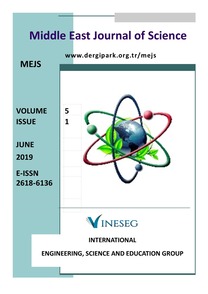DFT INVESTIGATION OF TRANSTION METALS ARENE COMPOUNDS WITHFUNCTIONALIZED IONIC LIQUID
DFT INVESTIGATION OF TRANSTION METALS ARENE COMPOUNDS WITHFUNCTIONALIZED IONIC LIQUID
___
- [1] [1] Gordon M.S., Schmidt M.W., “Advances in electronic structure theory: GAMESS a decade later”, In: “Theory and Applications of Computational Chemistry, the first forty years”, Dykstra C.E., Frenking G., Kim K.S., Scuseria G.E. (eds) Elsevier, Amsterdam, pp. 1167-1189, 2005.
- [2] Demircioğlu Z., Ersanlı C.C., Alpaslan G., “Calculations of Charge Transfer with DNA bases and Local&Global Chemical Activity by Computational Chemistry Method of (Z)-Ethyl 4-chloro-2- [2-(2-methoxyphenyl)hydrazono]-3-oxobutanoate Crystal”, Sinop University Journal of Natural Science, 4(2), 93-108, 2019. https://doi.org/10.33484/sinopfbd.562618
- [3] Hohenberg P., Kohn W., “Inhomogeneous Electron Gas”, Physical Review, 136(3B), B864-B871, 1964. https://doi.org/10.1103/PhysRev.136.B864
- [4] Obot I.B., Macdonald D.D., Gasem Z.M., “Density functional theory (DFT) as a powerful tool for designing new organic corrosion inhibitors. Part 1: An overview”, Corrosion Science, 99, 1- 30, 2015. https://doi.org/10.1016/j.corsci.2015.01.037
- [5] Riley K.E., Merz K.M., “Assessment of Density Functional Theory Methods for the Computation of Heats of Formation and Ionization Potentials of Systems Containing Third Row Transition Metals”, The Journal of Physical Chemistry A, 111(27), 6044-6053, 2007. https://doi.org/10.1021/jp0705931
- [6] Chaquin P. “Absolute electronegativity and hardness: An analogy with classical electrostatics suggests an interpretation of the Parr ‘electrophilicity index’ as a ‘global energy index’ leading to the ‘minimum electrophilicity principle”, Chemical Physics Letters, 458(1–3), 231-234, 2008. https://doi.org/10.1016/j.cplett.2008.04.087
- [7] Rafikova K., Binbay N.E., Meric N., Kerimkulova A., Zazybin A., Binbay V., Okumus V., Kayan C., Isık U., Arslan N., Aydemir M., “Biological assays and theoretical density functional theory calculations of Rh(I), Ir(III), and Ru(II) complexes of chiral phosphinite ligand”, Applied Organometallic Chemistry, 34, e5658, 2020. https://doi.org/10.1002/aoc.5658
- [8] Schmidt M.W., Baldridge K.K., Boatz J.A., Elbert S.T., Gordon M.S., Jensen J.H., Koseki S., Matsunaga N., Nguyen K.A., Su S., Windus T.L., Dupuis M., Montgomery J.A., “General Atomic and Molecular Electronic Structure System”, Journal of Computational Chemistry, 14, 1347-1363, 1993. https://doi.org/10.1002/jcc.540141112
- [9] Yanai T., Tew D.P., Handy N.C., “A new hybrid exchange–correlation functional using the Coulomb-attenuating method (CAM-B3LYP)”, Chemical Physics Letters, 393(1-3), 51-57, 2004. https://doi.org/10.1016/j.cplett.2004.06.011
- [10] Stevens W.J., Krauss M., Bash H., Jasien P.G., “Relativistic compact effective potentials and efficient, shared-exponent basis sets for the third-, fourth-, and fifth-row atoms”, Canadian Journal of Chemistry, 70, 612-630, 1992. https://doi.org/10.1139/v92-085
- [11] N. Arslan, “Enantioselective transfer hydrogenation of pro-chiral ketones catalyzed by novel ruthenium and iridium complexes of well-designed phosphinite ligand”, Phosphorus Sulfur Silicon and Related Elements, 195(8), 628-637, 2020. https://doi.org/10.1080/10426507.2019.1704285
- [12] Mashuga M.E., Olasunkanmi L.O., Ebenso E.E., “Experimental and theoretical investigation of the inhibitory effect of new pyridazine derivatives for the corrosion of mild steel in 1 M HCl”, Journal of Molecular Structure, 1136, 127-139, 2017. https://doi.org/10.1016/j.molstruc.2017.02.002
- [13] Murray J.S., Sen K., “Molecular Electrostatic Potentials, Concepts and Applications”, Elsevier, Amsterdam (1996).
- [14] Khemalapure S.S., Hiremath S.M., Hiremath C.S., Katti V.S., Basanagouda M.M., Khanal G.P., Karthick T., “Structural, spectroscopic and computational investigations on (4,6-dimethyl- benzofuran-3-yl)-acetic acid hydrazide”, Journal of Molecular Structure, 1220, 128748, 2020. https://doi.org/10.1016/j.molstruc.2020.128748
- [15] Hiremath S.M., Patil A.S., Hiremath C.S., Basangouda M., Khemalapure S.S., Patil N.R., Radder S.B., Armakovi S.J., Armakovi S., “Structural, spectroscopic characterization of 2-(5-methyl-1- benzofuran-3-yl) acetic acid in monomer, dimer and identification of specific reactive, drug likeness properties: Experimental and computational study”, Journal of Molecular Structure, 1178, 1-17, 2019. https://doi.org/10.1016/j.molstruc.2018.10.007
- [16] Sebastian Sr. S.H.R., Attia M.I., Almutairi M.S., El-Emam A.A., Panicker C.Y., Van Alsenoy C., “FT-IR, FT-Raman, molecular structure, first order hyperpolarizability, HOMO and LUMO analysis, MEP and NBO analysis of 3-(adamantan-1-yl)-4-(prop-2-en-1-yl)-1H-1,2,4-triazole- 5(4H)-thione, a potential bioactive agent”, Spectrochimica Acta Part A: Molecular and Biomolecular Spectroscopy, 132, 295-304, 2014. https://doi.org/10.1016/j.saa.2014.04.177
- [17] Abad N., Lgaz H., Atioglu Z., Akkurt M., Mague J.T., Ali I.H., Chung Ill.-M., Salghi R., Essassi El M., Ramli Y., “Synthesis, crystal structure, hirshfeld surface analysis, DFT computations and molecular dynamics study of 2-(benzyloxy)-3-phenylquinoxaline”, Journal of Molecular Structure, 1221, 128727, 2020. https://doi.org/10.1016/j.molstruc.2020.128727
- [18] Bredol M., Micior J., “Preparation and characterization of nanodispersions of yttria, yttrium aluminum garnet and lutetium aluminum garnet”, Journal of Colloid and Interface Science, 402, 27-33, 2013. https://doi.org/10.1016/j.jcis.2013.03.060
- [19] Howlett P.C., Izgorodina E.I., Forsyth M., MacFarlane D.R., “Electrochemistry at Negative Potentials in Bis(trifluoromethanesulfonyl)amide Ionic Liquids”, Zeitschrift für Physikalische Chemie, 220, 1483-1498, 2006. https://doi.org/10.1524/zpch.2006.220.10.1483
- [20] Bader R.F.W., Henneker W.H., Cade P.E., “Molecular Charge Distributions and Chemical Binding”, The Journal of Chemical Physics, 46, 3341-3363, 1967. https://doi.org/10.1063/1.1841222
- [21] Henn J., Leusser D., Stalke D., “Chemical Interpretation of Molecular Electron Density Distributions”, Journal of Computational Chemistry. 28, 2317-2324, 2007. https://doi.org/10.1002/jcc.20747
- [22] Domingo L.R., “Molecular Electron Density Theory: A Modern View of Reactivity in Organic Chemistry”, Molecules, 21(10), 1319, 2016. https://doi.org/10.3390/molecules21101319
- [23] Senthilkumar K., Kanagathara N., Natarajan V., Ragavendran V., Srinivasan T., Marchewka M.K., “Single crystal X-ray diffraction, spectral characterization, evaluation of electronic and chemical reactivity of tert-butylammonium N-acetylglycinate monohydrate - A DFT study”, Journal of Molecular Structure, 1220, 128764, 2020. https://doi.org/10.1016/j.molstruc.2020.128764
- [24] Erdoğan Ş., Safi Z.S., Kaya S., Özbakır Işın D., Guo L., Kaya C., “A computational study on corrosion inhibition performances of novel quinoline derivatives against the corrosion of iron”, Journal of Molecular Structure, 1134, 751-761, 2017. https://doi.org/10.1016/j.molstruc.2017.01.037
- [25] Wu S., Qi L., Ren Y., Ma H., “1,2,4-triazole-3-thione Schiff bases compounds: Crystal structure, hirshfeld surface analysis, DFT studies and biological evaluation”, Journal of Molecular Structure, 1219, 128591, 2020. https://doi.org/10.1016/j.molstruc.2020.128591
- [26] Madkour L.H., Kaya S., Guo L., Kaya C., “Quantum chemical calculations, molecular dynamic (MD) simulations and experimental studies of using some azo dyes as corrosion inhibitors for iron. Part 2: Biseazo dye derivatives”, Journal of Molecular Structure, 1163, 397-417, 2018. https://doi.org/10.1016/j.molstruc.2018.03.013
- ISSN: 2618-6136
- Yayın Aralığı: 2
- Başlangıç: 2015
- Yayıncı: -
Uğur IŞIK, Nermin MERİÇ, Murat AYDEMİR
Çağıl COŞKUN, Figen A. ÇİÇEK, Onur TOKGÜN, Işıl ÖCAL
DFT INVESTIGATION OF TRANSTION METALS ARENE COMPOUNDS WITHFUNCTIONALIZED IONIC LIQUID
Cezmi KAYAN, Nermin MERİÇ, Veysel BİNBAY, Murat AYDEMİR, Nil ERTEKİN BİNBAY
Şilan BATURAY, Serap YİĞİT GEZGİN, İlhan CANDAN, Hamdi Şükür KILIÇ
Canan AYTUĞ AVA, Şilan BATURAY
Zuhal ÇANKIRI, Murat AKKUŞ, Eda YILDIZHAN, Dilara AKINCI, Fırat AŞIR, Onur DEDE, Muhamet AFŞİN
